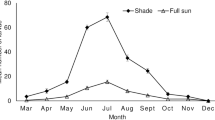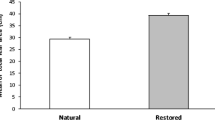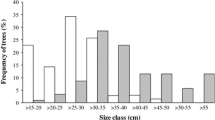Abstract
Light environments can influence variation in plant morphology, development and susceptibility to herbivores. Our research interest was to investigate the patterns of herbivore damage and developmental stability in dioecious understory forb Mercurialis perennis in contrasting light habitats, located at 1700 m a.s.l. on Mt. Kopaonik. Male and female plants from two light habitats, open (a sun-exposed field) and shaded (a spruce forest) were examined with respect to: herbivore damage (percentage of leaf area loss), fluctuating asymetry (FA) as a measurement of developmental stability, plant morphological and, specifically, leaf size traits, as well as biochemical traits relating to nutritional quality and defence, taking into account the possible presence of intersexual differences. Our results show that herbivore damage was significantly higher in open habitat, as well as one out of four univariate FA indices and the multivariate index. Morphological and biochemical traits, apart from defensive compounds, had higher values in the shade, pointing to sun-exposed habitat being more stressful for this species. Intersexual differences were observed for foliar damage, defensive compounds (phenolics and tannins), all leaf size traits, total leaf area, and protein content. Contrasting light habitats affected most of the analysed traits. Both foliar damage and FA were higher in a more stressful habitat; within habitats, no positive correlations were found. Herbivore damage was significantly male biased in open habitat. The analysis of intersexual differences in developmental stability measured by leaf asymmetry levels provided no evidence that female plants were more sensitive to environmental stress.





Similar content being viewed by others
References
Abràmoff MD, Magalhães PJ, Ram SJ (2004) Image processing with ImageJ. Biophotonics Int 11:36–42. https://imagescience.org/meijering/publications/download/bio2004.pdf
Alves-Silva E, Del-Claro K (2016) Herbivory-induced stress: Leaf developmental instability is caused by herbivore damage in early stages of leaf development. Ecol Indic 61:359–365. https://doi.org/10.1016/j.ecolind.2015.09.036
Anne PF, Mawri S, Gladstone DC (1998) Is fluctuating asymmetry a reliable biomonitor of stress? A test using life history parameters in soybean. Int J Plant Sci 159:559–565. https://doi.org/10.1086/297573
Auslander M, Nevo E, Inbar M (2003) The effects of slope orientation on plant growth, developmental instability and susceptibility to herbivores. J Arid Environ 55:405–416. https://doi.org/10.1016/S0140-1963(02)00281-1
Bañuelos MJ, Sierra M, Obeso JR (2004) Sex, secondary compounds and asymmetry: effects on plant–herbivore interaction in a dioecious shrub. Acta Oecol 25:151–157. https://doi.org/10.1111/j.1600-0706.2005.14075.x
Barbehenn RV, Constable CP (2011) Tannins in plant-herbivore interactions. Phytochemistry 72:1551–1565. https://doi.org/10.1016/j.phytochem.2011.01.040
Barrett SC, Hough J (2013) Sexual dimorphism in flowering plants. J Exp Bot 64:67–82. https://doi.org/10.1093/jxb/ers308
Bradford MM (1976) A rapid and sensitive method for the quantitation of microgram quantities of protein utilizing the principle of protein-dye binding. Anal Biochem 72:248–254. https://doi.org/10.1016/0003-2697(76)90527-3
Buckley NE, Avila-Sakar G (2013) Reproduction, growth, and defense trade-offs vary with gender and reproductive allocation in Ilex glabra (Aquifoliaceae). Am J Bot 100:357–364. https://doi.org/10.3732/ajb.1200603
Castagneyrol B, Giffard B, Péré C, Jactel H (2013) Plant apparency, an overlooked driver of associational resistance to insect herbivory. J Ecol 101(2):418–429. https://doi.org/10.1111/1365-2745.12055/full
Cepeda-Cornejo V, Dirzo R (2010) Sex-related differences in reproductive allocation, growth, defense and herbivory in three dioecious neotropical palms. PLoS One 5:e9824. https://doi.org/10.1371/journal.pone.0009824
Cornelissen T, Stiling P (2005a) Perfect is best: low leaf fluctuating asymmetry reduces herbivory by leaf miners. Oecologia 142:46–56. https://doi.org/10.1007/s00442-004-1724-y
Cornelissen T, Stiling P (2005b) Sex-biased herbivory: a meta-analysis of the effects of gender on plant-herbivore interactions. Oikos 111:488–500. https://doi.org/10.1111/j.1600-0706.2005.14075.x/full
Cornelissen T, Stiling P (2011) Similar responses of insect herbivores to leaf fluctuating asymmetry. Arthropod Plant Interact 5:59–69. https://doi.org/10.1007/s11829-010-9116
Cornelissen T, Wilson Fernandes G, Vasconcellos-Neto J (2008) Size does matter: variation in herbivory between and within plants and the plant vigor hypothesis. Oikos 117:1121–1130. https://doi.org/10.1111/j.0030-1299.2008.16588.x/full
Costa FVD, Pinheiro de Azevedo IF, Braga LDL, Perillo LN, Neves FDS, Leite LO, Cuevas-Reyes P (2013) Fluctuating asymmetry and herbivory in two ontogenetical stages of Chamaecrista semaphora in restored and natural environments. J Plant Interact 8:179–186. https://doi.org/10.1080/17429145.2012.657253
Cuevas-Reyes P, Oyama K, González-Rodríguez A, Fernandes GW, Mendoza-Cuenca L (2011) Contrasting herbivory patterns and leaf fluctuating asymmetry in Heliocarpus pallidus between different habitat types within a Mexican tropical dry forest. J Trop Ecol 27:383–391. https://doi.org/10.1017/S026646741100006X
Cuevas-Reyes P, Gilberti L, González-Rodríguez A, Fernandes GW (2013) Patterns of herbivory and fluctuating asymmetry in Solanum lycocarpum St. Hill (Solanaceae) along an urban gradient in Brazil. Ecol Indic 24:557–561. https://ac.els-cdn.com/S1470160X12003020/10.1016/j.ecolind.2012.08.011
Cvetković D, Jovanović V (2007) Altitudinal variation of the sex ratio and segregation by gender in the dioecious plant Mercurialis perennis L.(Euphorbiaceae) in Serbia. Arch Biol Sci 59:193–198. https://doi.org/10.2298/ABS0703193C
Elemans M (2004) Light, nutrients and the growth of herbaceous forest species. Acta Oecol 26:197–202. https://doi.org/10.1016/j.actao.2004.05.003
Espírito-Santo MM, Neves FS, Fernandes GW, Silva JO (2012) Plant phenology and absence of sex-biased gall attack on three species of Baccharis. PloS One 7:e46896. https://doi.org/10.1371/journal.pone.0046896
Fernandes GW, de Oliveira SCS, Campos IR, Barbosa M, Soares LA, Cuevas-Reyes P (2016) Leaf fluctuating asymmetry and herbivory of Tibouchina heteromalla in restored and natural environments. Neotrop Entom 45:44–49. https://doi.org/10.1007/s13744-015-0342-1
Freeman DC, Brown ML, Dobson M, Jordan Y, Kizy A, Micallef C, Emlen JM (2003) Developmental instability: measures of resistance and resilience using pumpkin (Cucurbita pepo L.). Bio J Linn Soc 78:27–41. https://doi.org/10.1046/j.1095-8312.2003.00123.x/full
Graham JH, Raz S, Hel-Or H, Nevo E (2010) Fluctuating asymmetry: methods, theory, and applications. Symmetry 2:466–540. http://www.mdpi.com/2073-8994/2/2/466
Hagen SB, Ims RA, Yoccoz NG, Sørlibråten O (2008) Fluctuating asymmetry as an indicator of elevation stress and distribution limits in mountain birch (Betula pubescens). Plant Ecol 195:157–163. https://doi.org/10.1007/s11258-007-9312-y
Hakes AS, Cronin JT (2012) Successional changes in plant resistance and tolerance to herbivory. Ecology 93:1059–1070. http://www.jstor.org/stable/23225222
Harris MS, Pannell JR (2008) Roots, shoots and reproduction: sexual dimorphism in size and costs of reproductive allocation in an annual herb. Proc R Soc B Biol Sci 275:2595–2602. http://rspb.royalsocietypublishing.org/content/275/1651/2595
Huberty AF, Denno RF (2004) Plant water stress and its consequences for herbivorous insects: a new synthesis. Ecology 85:1383–1398. https://doi.org/10.1890/03-0352/full
Inbar M, Kark S (2007) Gender-related developmental instability and herbivory of Pistacia atlantica across a steep environmental gradient. Folia Geobot 42:401–410. https://doi.org/10.1007/BF02861702
Jefferson RG (2008) Biological flora of the British isles: Mercurialis perennis L. J Ecol 96:386–412. https://doi.org/10.1111/j.1365-2745.2007.01348.x/full
Johnson MT (2011) Evolutionary ecology of plant defences against herbivores. Func Ecol 25:305–311. https://doi.org/10.1111/j.1365-2435.2011.01838.x/full
Juvany M, Munné-Bosch S (2015) Sex-related differences in stress tolerance in dioecious plants: a critical appraisal in a physiological context. J Exp Bot 66:6083–6092. https://doi.org/10.1093/jxb/erv343
Klingenberg CP (2015) Analyzing fluctuating asymmetry with geometric morphometrics: concepts, methods, and applications. Symmetry 7:843–934. http://www.mdpi.com/2073-8994/7/2/843
Klingenberg CP, Barluenga M, Meyer A (2002) Shape analysis of symmetric structures: quantifying variation among individuals and asymmetry. Evolution 56:1909–1920. https://doi.org/10.1111/j.0014-3820.2002.tb00117.x/full
Labouche AM, Pannell JR (2016) A test of the size-constraint hypothesis for a limit to sexual dimorphism in plants. Oecologia 181:873–884. https://doi.org/10.1007/s00442-016-3616-3
Lempa K, Martel J, Koricheva J, Haukioja E, Ossipov V, Ossipova S, Pihlaja K (2000) Covariation of fluctuating asymmetry, herbivory and chemistry during birch leaf expansion. Oecologia 122:354–360. https://doi.org/10.1007/s004420050041
Leung B, Forbes MR, Houle D (2000) Fluctuating asymmetry as a bioindicator of stress: comparing efficacy of analyses involving multiple traits. Am Nat 155:101–115. http://www.jstor.org/stable/10.1086/303298
Lusk CH, Onoda Y, Kooyman R, Gutiérrez-Girón A (2010) Reconciling species-level vs plastic responses of evergreen leaf structure to light gradients: shade leaves punch above their weight. New Phytol 186:429–438. https://doi.org/10.1111/j.1469-8137.2010.03202.x/full
Maldonado-López Y, Cuevas-Reyes P, Sánchez-Montoya G, Oyama K, Quesada M (2014) Growth, plant quality and leaf damage patterns in a dioecious tree species: is gender important? Arthropod Plant Interact 8:241–251. https://doi.org/10.1007/s11829-014-9314-3
Miljković D (2012) Developmental stability of Iris pumila flower traits: a common garden experiment. Arch Biol Sci 64:123–133. https://doi.org/10.2298/ABS1201123M
Møller AP, Shykoff JA (1999) Morphological developmental stability in plants: patterns and causes. Int J Plant Sci 160:S135–S146. https://doi.org/10.1086/314219
Moura RF, Alves-Silva E, Del-Claro K (2017) Patterns of growth, development and herbivory of Palicourea rigida are affected more by sun/shade conditions than by Cerrado phytophysiognomy. Acta Bot Bras 31:286–294. https://doi.org/10.1590/0102-33062016abb0446
Muth NZ, Kluger EC, Levy JH, Edwards MJ, Niesenbaum RA (2008) Increased per capita herbivory in the shade: necessity, feedback, or luxury consumption. Ecoscience 15:182–188. https://doi.org/10.2980/15-2-3095
Niesenbaum RA, Kluger EC (2006) When studying the effects of light on herbivory, should one consider temperature? The case of Epimecis hortaria F. (Lepidoptera: Geometridae) feeding on Lindera benzoin. L. (Lauraceae). Environ entomol 35:600–606. https://doi.org/10.1603/0046-225X-35.3.600
Nijhout HF, Davidowitz G (2003) Developmental perspectives on phenotypic variation, canalization, and fluctuating asymmetry. In: Polak M (ed), Developmental instability: causes and consequences. Oxford University Press, Oxford, pp 3–13. (ISBN: 0-19-514345-0)
Nikiforou C, Manetas Y (2017) Ecological stress memory: evidence in two out of seven species through the examination of the relationship between leaf fluctuating asymmetry and photosynthesis. Ecol Indic 74:530–534. https://doi.org/10.1016/j.ecolind.2016.11.004
Obeso JR (2002) The costs of reproduction in plants. New Phytol 155:321–348. https://doi.org/10.1046/j.1469-8137.2002.00477.x/full
Palmer AR, Strobeck C (2003) Fluctuating asymmetry analyses revisited. In: Polak M (ed) Developmental instability: causes and consequences. Oxford University Press, Oxford, pp 279–319
Puerta-Piñero C, Gómez JM, Hódar JA (2008) Shade and herbivory induce fluctuating asymmetry in a Mediterranean oak. Int J Plant Sci 169:631–635. http://www.jstor.org/stable/10.1086/533601
Ribeiro VA, Silva RND, Sousa-Souto L, Neves FDS (2013) Fluctuating asymmetry of and herbivory on Poincianella pyramidalis (Tul.) LP Queiroz (Fabaceae) in pasture and secondary tropical dry forest. Acta Bot Bras 27:21–25. https://doi.org/10.1590/S0102-33062013000100003
Roberts MR, Paul ND (2006) Seduced by the dark side: integrating molecular and ecological perspectives on the influence of light on plant defence against pests and pathogens. New Phytol 170:677–699. https://doi.org/10.1111/j.1469-8137.2006.01707.x/full
Sakai A, Sasa A, Sakai S (2006) Do sexual dimorphisms in reproductive allocation and new shoot biomass increase with an increase of altitude? A case of the shrub willow Salix reinii (Salicaceae). Am J Bot 93:988–992. http://www.amjbot.org/content/93/7/988.full.pdf+html
Salgado-Luarte C, Gianoli E (2010) Herbivory on temperate rainforest seedlings in sun and shade: resistance, tolerance and habitat distribution. PLoS One 5:e11460. https://doi.org/10.1371/journal.pone.0011460
Salgado-Luarte C, Gianoli E (2012) Herbivores modify selection on plant functional traits in a temperate rainforest understory. Am Nat 180:E42–E53. http://www.jstor.org/stable/10.1086/666612
Sánchez-Vilas J, Pannell JR (2011) Sex-differential herbivory in androdioecious Mercurialis annua. PloS One 6:e22083. https://doi.org/10.1371/journal.pone.0022083
Sandner TM, Matthies D (2017) Fluctuating asymmetry of leaves is a poor indicator of environmental stress and genetic stress by inbreeding in Silene vulgaris. Ecol Indic 79:247–253. https://doi.org/10.1016/j.ecolind.2017.04.030
Santos JC, Alves-Silva E, Cornelissen TG, Fernandes GW (2013) The effect of fluctuating asymmetry and leaf nutrients on gall abundance and survivorship. Basic Appl Ecol 4:489–495. https://doi.org/10.1016/j.baae.2013.06.005
Sheets HD (2003) IMP— Integrated Morphometrics Package. Buffalo: Department of physics, Canisius College. http://www3.canisius.edu/~sheets/morphsoft.html
Silva HV, Alves-Silva E, Santos JC (2016) On the relationship between fluctuating asymmetry, sunlight exposure, leaf damage and flower set in Miconia fallax (Melastomataceae). Trop Ecol 57:419–427. http://tropecol.com/pdf/open/PDF_57_3/4%20Venancio%20Silva,%20Alves-Silva%20&%20Santos-f.pdf
Singleton VL, Rossi JA (1965) Colorimetry of total phenolics with phosphomolybdic-phosphotungstic acid reagents. Am J Enol Viticult 16:144–158. http://www.ajevonline.org/content/16/3/144
Suárez-Piña J, Rueda-Almazán JE, Ayestarán LM, Alcalá RE (2016) Effect of light environment on intra-specific variation in herbivory in the carnivorous plant Pinguicula moranensis (Lentibulariaceae). J Plant Interact 11:146–151. https://doi.org/10.1080/17429145.2016.1231851
Takafumi H, Kawase S, Nakamura M, Hiura T (2010) Herbivory in canopy gaps created by a typhoon varies by understory plant leaf phenology. Ecol Entom 35:576–585. https://doi.org/10.1111/j.1365-2311.2010.01216.x/full
Telhado C, Esteves D, Cornelissen T, Fernandes GW, Carneiro MAA (2010) Insect herbivores of Coccoloba cereifera do not select asymmetric plants. Environ Entom 39:849–855. https://doi.org/10.1603/EN09179
Telhado C, Silveira FAO, Fernandes GW, Cornelissen T (2017) Fluctuating asymmetry in leaves and flowers of sympatric species in a tropical montane environment. Plant Spec Biol 32:3–12. https://doi.org/10.1111/1442-1984.12122/full
Valladares F, Niinemets Ü (2008) Shade tolerance, a key plant feature of complex nature and consequences. Annu Rev Ecol Evol Syst 39:237–257. https://doi.org/10.1146/annurev.ecolsys.39.110707.173506
Valladares F, Laanisto L, Niinemets Ü, Zavala MA (2016) Shedding light on shade: ecological perspectives of understorey plant life. Plant Ecol Divers 9:237–251. https://doi.org/10.1080/17550874.2016.1210262
Vandepitte K, Roldán-Ruiz I, Leus L, Jacquemyn H, Honnay O (2009) Canopy closure shapes clonal diversity and fine-scale genetic structure in the dioecious understorey perennial Mercurialis perennis. J Ecol 97:404–414. https://doi.org/10.1111/j.1365-2745.2009.01484.x/full
Vandepitte K, Honnay O, De Meyer T, Jacquemyn H, Roldán-Ruiz I (2010) Patterns of sex ratio variation and genetic diversity in the dioecious forest perennial Mercurialis perennis. Plant Ecol 206:105–114. https://doi.org/10.1007/s11258-009-9627-y
Venâncio H, Alves-Silva E, Santos JC (2016) Leaf phenotypic variation and developmental instability in relation to different light regimes. Acta Bot Bras 30:296–303. https://doi.org/10.1590/0102-33062016abb0081
Vujić V, Rubinjoni L, Selaković S, Cvetković D (2016) Small-scale variations in leaf shape under anthropogenic disturbance in dioecious forest forb Mercurialis perennis: a geometric morphometric examination. Arch Biol Sci 68:705–713. https://doi.org/10.2298/ABS151111011V
Wadhwa S, Gallagher FJ, Rodriguez-Saona C, Holzapfel C (2017) Exposure to heavy metal stress does not increase fluctuating asymmetry in populations of isopod and hardwood trees. Ecol Indic 76:42–51. https://doi.org/10.1016/j.ecolind.2016.12.037
Weijschedé J, Martínková J, De Kroon H, Huber H (2006) Shade avoidance in Trifolium repens: costs and benefits of plasticity in petiole length and leaf size. New Phyt 172:655–666. https://doi.org/10.1111/j.1469-8137.2006.01885.x/full
Wright VL, Dorken ME (2014) Sexual dimorphism in leaf nitrogen content but not photosynthetic rates in Sagittaria latifolia (Alismataceae). Botany 92:109–112. https://doi.org/10.1139/cjb-2013-0246
Xu BJ, Chang SKC (2007) A comparative study on phenolic profiles and antioxidant activities of legumes as affected by extraction solvents. J Food Sci 72:S159–S166. https://doi.org/10.1111/j.1750-3841.2006.00260.x/abstract
Zhang L, Yang M, Gao J, Jin S, Wu Z, Wu L, Zhang X (2016) Seasonal variation and gender pattern of phenolic and flavonoid contents in Pistacia chinensis Bunge inflorescences and leaves. J Plant Phys 191:36–44. https://doi.org/10.1016/j.jplph.2015.11.014
Zvereva EL, Kozlov M, Niemelä VP, Haukioja E (1997) Delayed induced resistance and increase in leaf fluctuating asymmetry as responses of Salix borealis to insect herbivory. Oecologia 109:368–373. https://doi.org/10.1007/s004420050095
Acknowledgements
This study was supported by the Ministry of Education, Science and Technological Development of the Republic of Serbia Grant No. 173025 title “Evolution in heterogeneous environments: mechanisms of adaptation, biomonitoring and conservation of biodiversity” and Grant No. 173005 title “Molecular mechanisms of plant response to abiotic stress—the role of transcription factors and small RNAs and analysis of genetic diversity of plant crops of interest for agriculture and biotechnology”.
Author information
Authors and Affiliations
Contributions
DM and DC conceived the idea and designed the study. SS, VV and DC conducted fieldwork. NS, SS and SR performed biochemical analyses, VV and SS performed herbivory analyses, DM performed statistical analyses. SS, DM and DC wrote the draft, DC and DM wrote the final version of the manuscript.
Corresponding author
Ethics declarations
Conflict of interest
The authors confirm that there is no conflict of interest in relation to this article.
Rights and permissions
About this article
Cite this article
Miljković, D., Selaković, S., Vujić, V. et al. Patterns of herbivore damage, developmental stability, morphological and biochemical traits in female and male Mercurialis perennis in contrasting light habitats. Alp Botany 128, 193–206 (2018). https://doi.org/10.1007/s00035-018-0203-8
Received:
Accepted:
Published:
Issue Date:
DOI: https://doi.org/10.1007/s00035-018-0203-8




